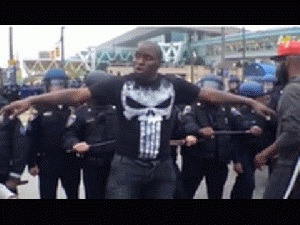Cross-posted from Truthdig
Lesson No. 1. A nonviolent movement that disrupts the machinery of state and speaks a truth a state hopes to suppress has the force to terrify authority and create deep fissures within the power structure. The ruling elites in China, we now know from leaked internal documents and the work of a handful of historians, believed the protests had the potential to dislodge them from power. Monolithic power, as we saw in China, is often a mirage. Some of the internal documents that exposed the fears and deep divisions within the ruling elite have been collected by the Princeton University Library.
Lesson No. 2. An uprising or a revolution usually follows a period of relative prosperity and liberalization. It is ignited not by the poor but by middle-class and elite families' sons and daughters, often college-educated, whom Mikhail Bakunin called declasse intellectuals, and who are being denied opportunities to advance socially and economically.
This is what happened in China. Chairman Mao Zedong's death in 1976 saw Deng Xiaoping assume leadership. Deng instituted political and free market reforms. The reforms created a new oligarchy. It led to widespread corruption, especially among the party elites. For workers there was a loss of job security and social benefits, including medical care and subsidized housing. University graduates were no longer guaranteed jobs, and many could not find employment.
The political liberalization that followed the terror of the Cultural Revolution expanded internal freedoms. A mixture of declining expectations, especially among college graduates, and the political opening provided the classic tinder for revolt. Political theorists such as James C. Davies and Crane Brinton have found that a period of relative liberalization coupled with declining prospects for advancement commonly precedes revolutions.
Once a regime abolishes civil liberties and acts in the middle of an uprising to restore "order," resistance becomes more dangerous. The Chinese government, after suffering more than a month of protests, declared martial law on May 20, 1989. Nonviolent mass demonstrations, while costly in human terms, often are more effective in totalitarian societies. Fear and forced submission to power are the only weapons left in the arsenal of the ruling class at such a point; when people are no longer afraid, the regime loses control.
Lesson No. 3. Radical mass movements often begin by appealing respectfully to authority for minimal reforms. The students, gathering in Tiananmen Square to mourn Hu, asked that the Chinese constitution, with its guarantees of rule of law and freedom of speech, be respected. Radicalization within the movement happened in the midst of the demonstrations. Once a movement educates itself about structures of power, and once those in state authority display their indifference to the tepid demands of the demonstrators, a movement becomes bolder and wiser. The Tiananmen Square occupation, begun as a spontaneous reaction to a death, swiftly evolved into a revolt. Students eventually drafted what became known as the Seven Demands. These were:
--Affirm as correct Hu Yaobang's views on democracy and freedom;--Admit that the campaigns against spiritual pollution and bourgeois liberalization had been wrong;
--Publish information on the incomes of state leaders and their family members;
--End the ban on privately run newspapers and stop press censorship;
--Increase funding for education and raise intellectuals' pay;
--End restrictions on demonstrations in Beijing;
--Provide objective coverage of students in official media.
Lesson No. 4. Once declasse intellectuals make alliances with the working class, a regime is in serious danger. The protest by the students resonated throughout China. Thousands of people, many from the working class, held their own demonstrations in cities across the country. Workers in Beijing rallied to the students. The state's relentless demonization of the protesters, something we saw in the United States in response to actions of the Occupy movement, was aimed primarily at preventing a student/worker alliance. Once the crackdown was complete, many workers who had taken part were executed. Student leaders, who came from families with connections and privilege, were usually given prison sentences.
Lesson No. 5. The most potent weapon in the hands of nonviolent rebels is fraternizing with and educating civil servants as well as the police and soldiers, who even though they suffer from the same economic inequality usually are under orders to crush protest. This demands a counterintuitive response from protesters. They must show respect and even compassion to forces deployed to stop the rebellion. Demonstrators are required to exercise tremendous self-discipline as they endure acts of violence and repression. They must refuse to retaliate. If bonds of sympathy are established between protesters and some of the police and soldiers, the ruling elites are unsure whether they can trust the security apparatus to obey. This engenders paralysis within the centers of power. In China the ruling Communist Party watched in dismay May 20 as the initial military assault to crush the protesters failed. Thousands of people surrounded military vehicles. They spoke to the soldiers about the reasons for the protests. They offered them food and water and invited them into their homes. Friendships were formed. The protesters and their supporters built so much solidarity with the soldiers that the government was forced to withdraw the military from Beijing four days later.
Lesson No. 6. When a major authority figure, even in secret, denounces calls to crush a resistance movement the ruling elites are thrown into panic. Maj. Gen. Xu Qinxian, leader of the 38th Group Army, refused to authorize an attack on the unarmed protesters in the square, saying, "I'd rather be beheaded than be a criminal in the eyes of history," according to the historian Yang Jisheng. He was stripped of his command and arrested. His refusal sent shock waves throughout the rulers, especially after seven senior commanders signed a petition that called on the leadership to withdraw the troops. In many uprisings the ruling elites, after members of their inner circle defect, see distrust and potential disobedience among other authority figures, even those who are loyal. To protect themselves the elites carry out internal purges, such as those conducted in the Soviet Union by Josef Stalin -- purges that are self-destructive. One person in authority saying "no" is an effective form of resistance. The elites know that if enough people refuse to co-operate they are doomed. They cannot let this spread.
(Note: You can view every article as one long page if you sign up as an Advocate Member, or higher).






